 Shad Boat (Barfield 1995:186)
Shad Boat (Barfield 1995:186)
Around the mid-1800s many logs that were suitable for dugouts, split-dugouts, and periaugers had been hard to find. Furthermore, these small boats were unable to deal with the work that was becoming commonplace in the region. Due to these factors, a new type of vessel was created by a Roanoke Island boatbuilder named George Washington Creef. Unlike the boats that were replaced by the shad boat, this vessel combined the traditional methods of dugouts with a plank on frame construction.
 Sketch of a Shad Boat (Alford 1990:20)
Sketch of a Shad Boat (Alford 1990:20)
As a result of this construction technique, Creef was able to create a boat with a curving hull design, wide-body, and lean ends to be able to cut through the rough waters near the various inlets of the Outer Banks. This design became popularly used since it was ideal for use in pound-net fishing and work in the open sounds. Beyond its workmanship, this vessel became widely known for its safety and comfort in rough conditions.
At first, these vessels were powered by sail using a sprit mainsail and jib. However, around the turn of the century shad boats began to evolve to take small engines. These new motor-powered shad boats lost the rounded bottom that they were designed with and instead changes to a deadrise hull. Despite this small change, these later boats were not as durable as the round bottom shad boats, possibly due to the cheaper construction techniques.
During Prohibition, another form of shad boat was developed: the mail boat. These vessels were designed to carry mail and other light cargo (hence the name), however, during Prohibition these vessels also became commonly used by smugglers would deliver illicit alcohol. These vessels were longer, sleeker, and had a more decorative bow and stern than normal shad boats and as a result of their purpose were also outfitted with larger engines.
 Sketch of a Mail Boat (Alford 1990:22)
Sketch of a Mail Boat (Alford 1990:22)
In 1987, the North Carolina General Assembly passed a bill that declared the shad boat to be the ‘State boat of North Carolina.’ The reason for this declaration was the history of this vessel and how tied it was to the development of the North Carolina economy (Alford 1990:18-22).
By Caleb O’Brien
